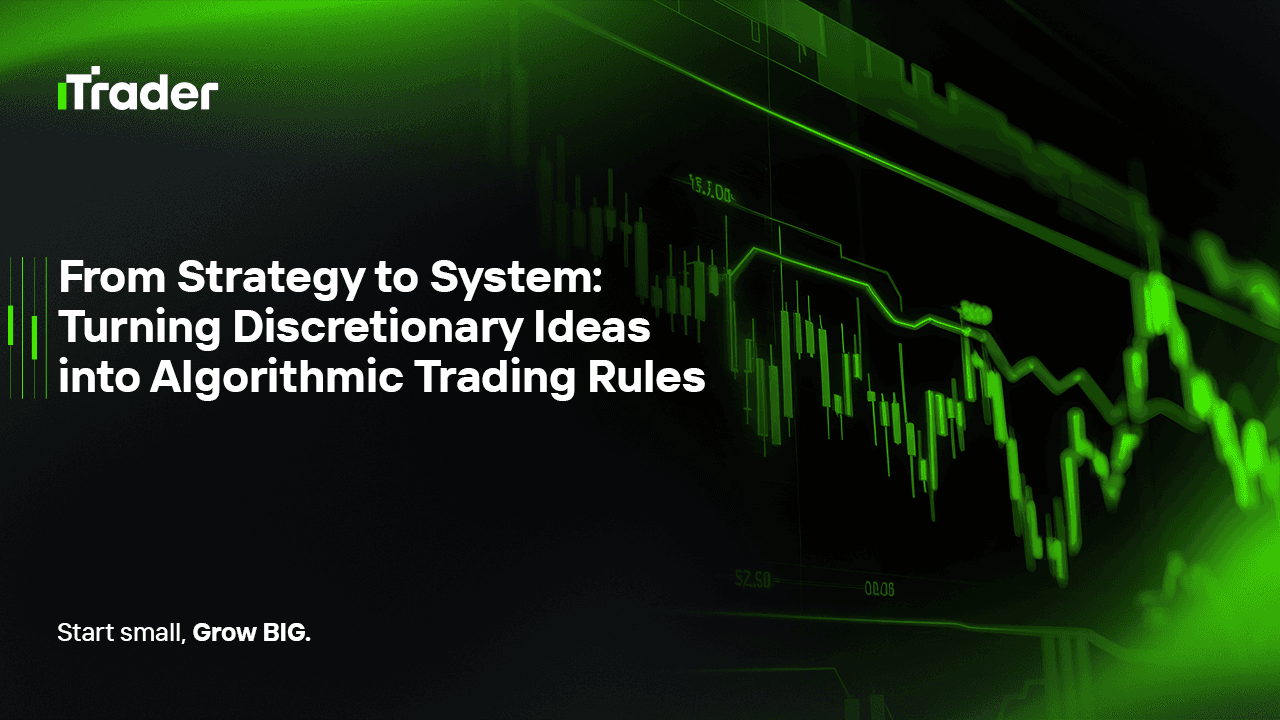2025-09-25
Most traders begin their journey by trading discretionary — relying on their eyes, instincts, and past experience to make decisions in the moment. There’s nothing wrong with that. In fact, many great insights are born from seeing patterns on a chart and trusting your gut.
But there’s a problem. Intuition doesn’t scale. It can’t be backtested. And when pressure mounts — especially under prop firm evaluation rules — emotions creep in, decisions change, and discipline slips.

That’s why serious traders eventually take the step from strategy to system: transforming their discretionary ideas into clear, testable, rule-based frameworks. In this article, we’ll look at how to make that shift, why it matters in the prop trading world, and what tools you can use to bring your trading to the next level.
Discretionary trading means you’re calling the shots in real time. You spot a pattern, read price action, maybe factor in the news, and decide: “This looks like a good entry.”
Systematic trading, on the other hand, is built on rules. Every trade follows predefined conditions, which means the strategy can be tested, measured, and even automated.
For prop firm traders, systematic approaches are a necessity. Firms don’t just care about making money — they care about risk control, discipline, and repeatability. A system gives you all three.
Every discretionary decision has hidden logic behind it. Maybe you saw price “reject” a level. Maybe you noticed momentum fading before a breakout. The key is to translate those observations into conditions that can be measured.
Example:
It’s the same insight — but expressed in a way that can be tested, repeated, and tracked.
To turn an idea into a system, think in components:
Each rule removes uncertainty and brings structure to your trading.
Once your rules are clear, they need proof.
A system isn’t proven until it survives both.
Not every trader wants to hand over all decisions to an algorithm. That’s fine. Many successful prop traders use hybrid systems:
This balance keeps discipline in place while still allowing for human judgment when it matters most.
Prop firms are strict about rules: daily loss limits, maximum drawdowns, position sizing caps. Without a system, it’s easy to break those rules accidentally. With one, you stay in line by default.
More importantly, systems deliver what prop firms value:
Turning ideas into systems is easier than ever:
You don’t need to be a programmer to start. Even partial rule-building makes your trading more disciplined.
Moving from discretionary trading to rule-based systems isn’t about losing creativity — it’s about bottling your insights into something repeatable.
The steps are simple:
The truth is this: good traders rely on instinct, but great traders systematize their instincts into rules that work under pressure. That’s the difference between passing a prop firm challenge and building a career in trading.
© 2025 iTrader Global Limited | หมายเลขทะเบียนบริษัท: 15962
iTrader Global Limited ตั้งอยู่ที่ Hamchako, Mutsamudu, เกาะปกครองตนเอง Anjouan, สหภาพคอโมโรส และได้รับใบอนุญาตและอยู่ภายใต้การกำกับดูแลของคณะกรรมการหลักทรัพย์แห่งคอโมโรส ภายใต้หมายเลขใบอนุญาต L15962/ITGL
iTrader Global Limited ดำเนินการภายใต้ชื่อทางการค้า “iTrader” และได้รับอนุญาตให้ดำเนินกิจกรรมการซื้อขายฟอเร็กซ์ โลโก้ เครื่องหมายการค้า และเว็บไซต์ของบริษัทเป็นทรัพย์สินเฉพาะของ iTrader Global Limited
บริษัทย่อยอื่น ๆ ของ iTrader Global Limited ได้แก่ iTrader Global Pty Ltd หมายเลขทะเบียนบริษัทออสเตรเลีย (ACN): 686 857 198 โดยบริษัทนี้เป็นตัวแทนที่ได้รับอนุญาต (หมายเลขตัวแทนบริการทางการเงินของออสเตรเลีย (AFS): 001315037) ของ Opheleo Holdings Pty Ltd (ใบอนุญาตบริการทางการเงินของออสเตรเลีย (AFSL): 000224485) ซึ่งมีที่อยู่จดทะเบียนอยู่ที่ Level 1, 256 Rundle St, Adelaide, SA 5000 ข้อจำกัดความรับผิดชอบ: นิติบุคคลนี้ไม่ใช่ผู้ออก และไม่รับผิดชอบต่อผลิตภัณฑ์ทางการเงินที่ซื้อขายบนหรือผ่านเว็บไซต์นี้
คำเตือนความเสี่ยง: การซื้อขาย CFD มีความเสี่ยงสูงต่อการสูญเสียเงินทุนอย่างรวดเร็วเนื่องจากเลเวอเรจ และอาจไม่เหมาะสมกับผู้ใช้ทุกคน
การซื้อขายกองทุน CFD และผลิตภัณฑ์ที่มีเลเวอเรจสูงอื่น ๆ ต้องการความรู้เฉพาะทาง
จากผลการวิจัยพบว่า 84.01% ของผู้เทรดที่ใช้เลเวอเรจประสบกับการขาดทุน
โปรดตรวจสอบให้แน่ใจว่าคุณเข้าใจความเสี่ยงทั้งหมด และพร้อมที่จะสูญเสียเงินทุนก่อนที่คุณจะเข้าร่วมการซื้อขายที่มีเลเวอเรจ
iTrader ขอประกาศว่า บริษัทจะไม่รับผิดชอบต่อความเสี่ยง ความเสียหาย หรือการสูญเสียใด ๆ ที่เกิดขึ้นจากการซื้อขายแบบมีเลเวอเรจต่อบุคคลหรือนิติบุคคลใด ๆ ทั้งสิ้น
ข่าวสารและข้อมูลที่ปรากฏบนเว็บไซต์นี้มีไว้เพื่อวัตถุประสงค์ทางการศึกษาเท่านั้น ผู้ใช้ควรตัดสินใจทางการเงินอย่างอิสระและโดยใช้ข้อมูลอย่างรอบคอบ
ข้อจำกัด: iTrader ไม่ได้มุ่งเป้าเว็บไซต์หรือบริการไปยังผู้อยู่อาศัยในประเทศที่กฎหมายหรือข้อบังคับห้ามไม่ให้มีการทำธุรกรรมดังกล่าว
หากคุณอาศัยอยู่ในเขตอำนาจที่การใช้เว็บไซต์หรือบริการนี้ถูกจำกัด คุณต้องรับผิดชอบในการปฏิบัติตามกฎหมายท้องถิ่น
iTrader ไม่รับประกันว่าเนื้อหาบนเว็บไซต์ของบริษัทจะเหมาะสมหรือถูกต้องตามกฎหมายในทุกพื้นที่